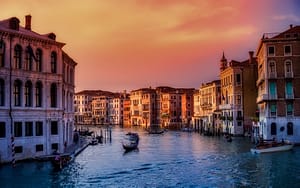Vaporetti
The word vaporetto originally referred to little steamers which plied Venice’s waters, but nowadays the term is loosely used to describe the city’s various types of public ferry service. Other terms you may hear are motoscafo, battello (boat) and its Venetian dialect version bateo. Venice’s waterbuses vary in size and comfort. Most have seats inside and out – the outdoor ones, of course, are the favourites of tourists. Sitting in the open at the back or front of a vaporetto is one of the very best ways of enjoying the Grand Canal. Round the outside of the island, waters can get choppy, making an outdoor seat rather more exciting, and sometimes damp. In the winter months, don’t forget to wrap up very warmly if you’ll be spending much time on the water. Vaporetti can get very crowded, and tourists should be alert to the crew’s instructions to move down inside the boats.
Car
Apart from the Lido (the island separating the lagoon from the Adriatic sea) and Sant’Erasmo, there are no roads after Piazzale Roma.
There are regular ferry services to the Lido to get your vehicle across (which is time consuming, so consider this carefully). Best check with your hosts, to evaluate this option.
Boat
If you want to get around a bit more quickly, there are numerous vaporetti (water buses, sing.: vaporetto) serving the Canal Grande, the larger canals through Venice and the surrounding islands (Lido, La Guidecca, Murano, Burano, and so on).
The vaporetti are generally the best way to get around for longer trips or for crossing the Canal Grande away from the bridges. Lines 1 and 2 go all the way along the Canal Grande and offer an easy sightseeing trip.
Water taxi
Water taxis are the most flexible and most expensive travel option in Venice. They operate at all times and offer the closest access from/to your destination. Prices inside Venice start from around 40-50 EUR (which will bring you a distance that is also easily walked) and depend on distance and time of day.
Gondola
These days, gondolas are mostly used for scenic purposes instead of actual transport from point A to point B. There are many stops dotted around the areas frequented by tourists and they are readily obvious, even when the gondolieri dress in something warmer then straw boaters and striped tops.
(Daytime) Prices start at around 80 EUR for 30 minutes and gondolas comfortably take 4 people, with a maximum of 6. Seated only, with some seats facing backwards.
Traghetto
The traghetto is the cheapest way to cross the Grand Canal without using the bridges. These are public shared gondolas operated by two gondolieri and are a lot cheaper than paying €80 for a private one. It costs only 2 Euros per person (cash only, preferably coins!) for tourists (70 cents for locals) – you can then say you went in a gondola, even if it was only for a couple of minutes! There are 7 piers for traghetti along the canal. Simply look for straight lines across the canal in the map, or follow the “traghetto” signs. Bear in mind that you are expected to stand, especially when it’s crowded and that luggage is usually not taken on.
On Foot
This is definitely the best way to experience Venice. Venice itself is not a large city. Most destinations across the city can be reached within 20 minutes of walking, if you know your way and can stay clear of tourist congestions. This beats most transport by boats.

